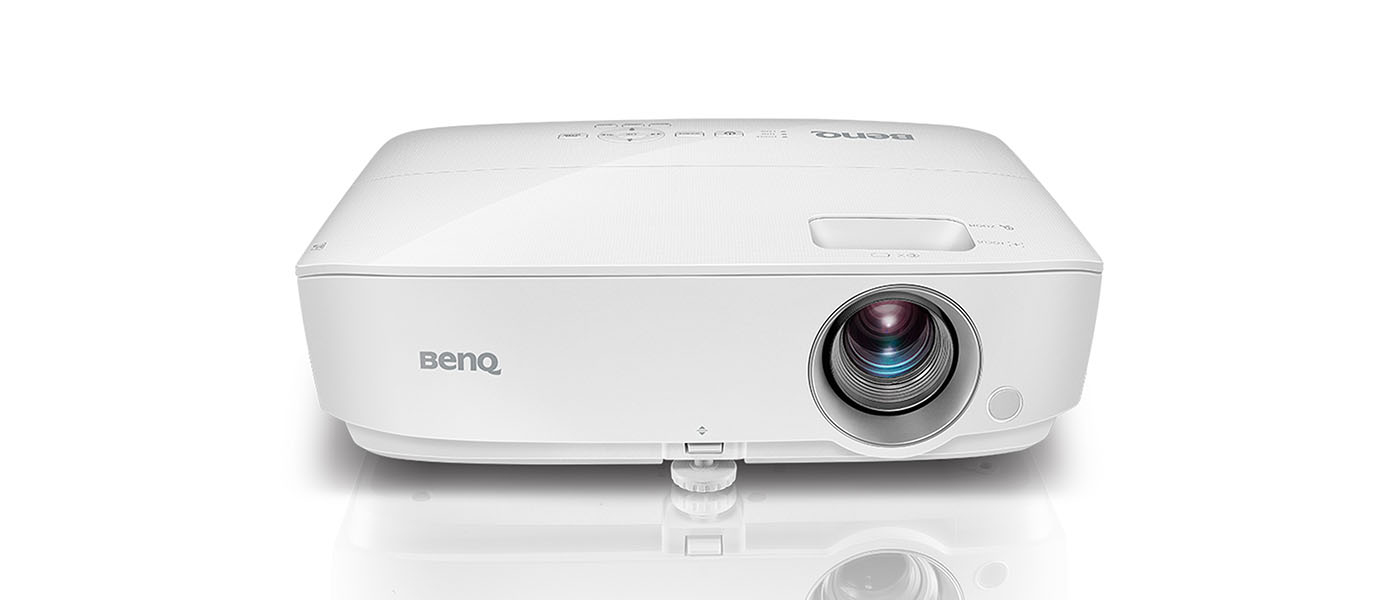Today, I’m checking out the HT3050 3D DLP Projector. It offers 2000 lumens, 100% Rec.709 color, full calibration controls including ISF modes, and 3D support. At $899, you’d expect a few corners to be cut but this projector is all-in when it comes to image quality. A cinema-grade lens with a low-dispersion coating means clarity from edge-to-edge. A single-chip DLP design ensures perfect convergence and the sharpest possible image. You even get vertical lens shift to aid installation. Built-in speakers mean you can take the HT3050 on the road. It’s an impressive package that costs less than many flat-panel TVs.
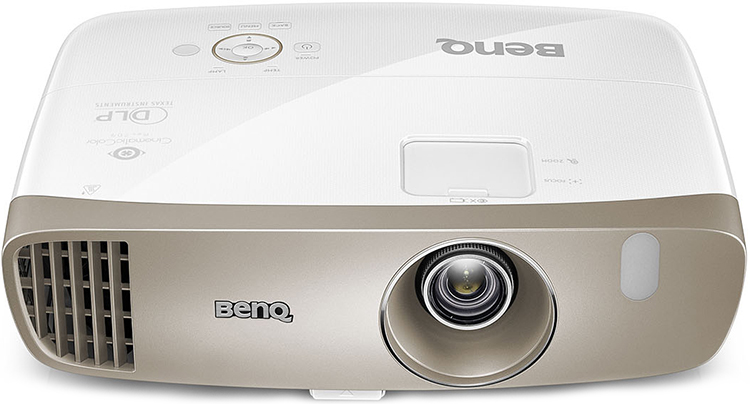
BenQ HT3050 3D DLP Projector
- 2000 lumens output
- Accurate Rec.709 CinematicColor™
- Single-chip DLP with 6x-speed color wheel
- Compact chassis with quiet fan
- High-quality optics
- Built-in stereo speakers
There are many companies marketing DLP projectors but few have shown the dedication to performance and value that BenQ has. I’ve reviewed a good number of their displays and have never been disappointed in the level of quality you get for the money. The HT3050 3D DLP Projector is a compact model with 2000 lumens, 3D, and a single-chip DLP light engine. It can serve equally well as a dedicated home theater display with its accurate Rec.709 color gamut, or as a portable projector for those seeking entertainment on the go. Its lightweight chassis clocks in at just 7.9lbs and features built-in speakers, so all you need to add is a source component. The well-stocked input panel supports just about anything from Blu-ray players to laptop computers. Vertical lens shift makes installation easy. You can set the HT3050 up just about anywhere. Today, I’ll be setting it up at my house to both measure and enjoy it. Let’s take a look.
Type:
Single-chip DLP
Native resolution:
1920×1080
Color wheel:
RGBRGB, 6x @ 50Hz, 4x @ 60Hz
3D:
Frame pack, top/bottom, side-to-side
Throw ratio:
1.15-1.5
Lens offset:
105%
Lens shift:
10% vertical
Maximum image size:
300”
Anamorphic lens support:
No
Auto-iris:
No
Bulb output modulation:
yes
Light output (mfr):
2000 lumens
Bulb power:
240w
Fan noise:
29/27dB
Video connections:
2 x HDMI (1 w/MHL), 1 x VGA, 1 x component, 1 x composite
Audio:
1 x RCA in, 1 x 3.5mm in, 1 x 3.5mm out
Speakers:
2 x 10w
Additional connections:
2 x USB, 1 x RS-232, 1 x 12v trigger
Lamp service life:
3500/5000/6000 hours
Dimensions:
15" x 4.8" x 10.9” (WxHxD)
Weight:
7.9lbs
Warranty:
One year, 180 days or 500 hours on lamp
BenQ HT3050 3D DLP Projector Price:
$899
Company:
SECRETS Tags:
BenQ HT3050 3D DLP Projector, DLP Projector, 3D Projector, BenQ, Projector Reviews 2017
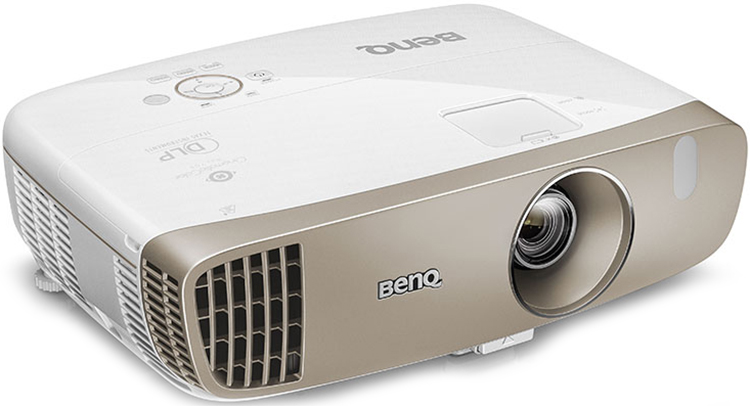
The HT3050 is a single-chip DLP design with a six-segment color wheel in an RGBRGB configuration. It spins at 4x speed at 60Hz which should eliminate the rainbow effect for all but the most sensitive viewers. I am not prone to seeing it and experienced no artifacts during my review, even when flicking my eyes back and forth.
A 240-watt bulb provides a claimed 2000 lumens of output. It is cooled by a very quiet fan and runs in three power modes, Normal, Economic, and SmartEco. The last one modulates brightness much like an auto-iris and helps improve contrast. It is effective both visually and in my tests, which revealed a 35% increase in dynamic range when engaged. I used it for all my viewing and never saw any image pumping. BenQ describes the HT3050 as “CinematicColor”, which is a reference to its accurate Rec.709 color gamut. My tests agree with that assessment. This is a very accurate projector.
The chassis is compact and light at just under eight pounds. While not the smallest projector from BenQ, it is perfectly portable and includes two built-in speakers to support that. They offer 10 watts apiece and play with ample volume and no audible distortion. Frequencies tend to the high mid-range but if you don’t have a home theater system handy, they work just fine.

The lens is mounted in a recess and off-center by just a little. The front of the chassis is finished in a matte-gold color with a large vent to help move air through. Also here is an IR sensor which proved to be very responsive to the excellent remote.
Image alignment is achieved by an extendable foot at the front and two leveling feet at the rear. If you must angle the projector relative to the screen, a keystone adjustment is provided in the OSD. I recommend avoiding this whenever possible as it reduces resolution.
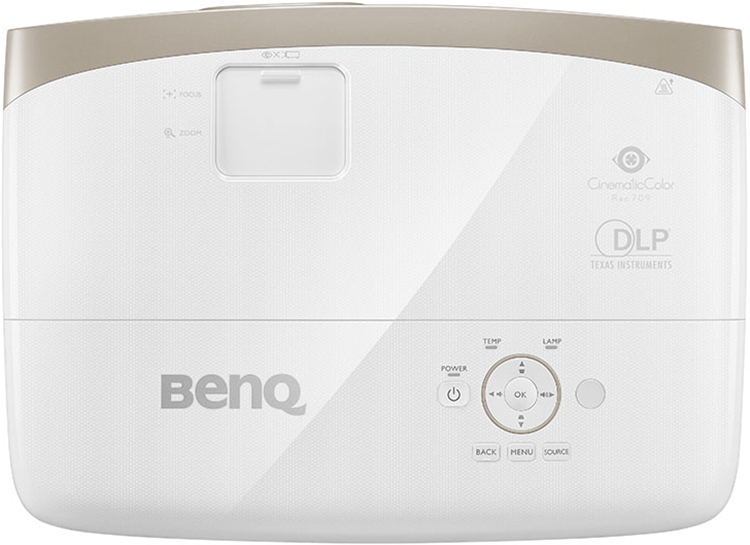
The lens controls are up top under a sliding door. That’s important because once you make your zoom, focus, and shift adjustments, you’ll want to close that door to prevent light leakage. The large side grills also leak a little but I did not find it to be distracting, even when the projector was in front of my seating. Also available here are a power toggle, menu navigation, source selection, and volume.

The input panel is well-equipped with two HDMI ports (one MHL), plus component, composite, and VGA connections. Audio is supported by RCA and 3.5mm inputs and a 3.5mm output. Service ports include two USB jacks.
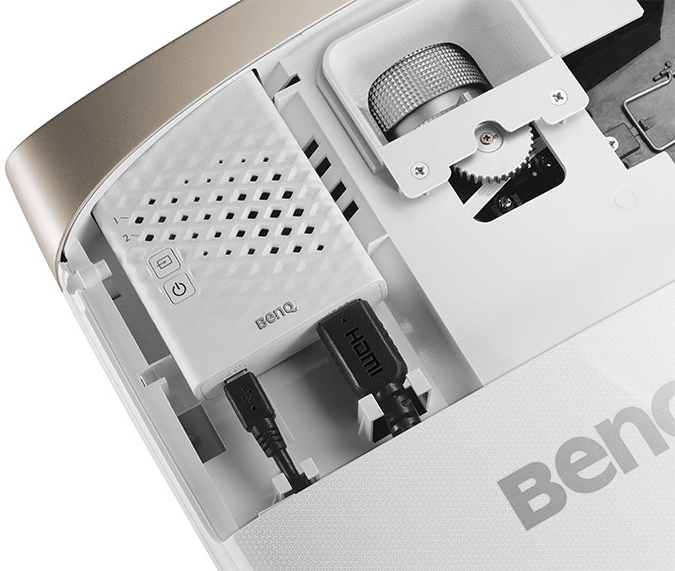
Wireless HDMI can be added by using the Wireless Full HD Kit (WDP02). It installs out of sight under the HT3050’s top cover. Power is provided by the USB mini port and it adds a third HDMI input to the projector.

The remote is extremely well-designed with a red-tinted backlight. It’s small but manages to pack every needed function into keys that click satisfyingly. You get discrete power buttons, menu navigation, one-key access to most calibration adjustments, and transport controls for the HDMI-CEC feature. IR commands can be bounced off the screen with ease as the projector has multiple receivers that never fail to pick up a signal.
The HT3050 supports all commonly-used 3D formats with glasses available separately. You can use BenQ’s or any DLP-Link-compatible models. I pulled out my trusty pair of XPand specs to watch 3D Blu-rays.
Users familiar with BenQ projectors won’t have to learn anything new when installing the HT3050. Its menu system is unchanged from other models I’ve reviewed and is very intuitive. To begin, I connected a pattern generator and my OPPO BDP-93 to the two HDMI ports. Lens shift is limited to just 10% vertical so you’ll need to install the projector close to the plane of the screen’s top or bottom edge. Zoom range is generous so I had little trouble filling my 92” Stewart Luminesse from about 10 feet away.
The menu system has basic and advanced modes which can be changed at any time. Basic offers image presets, position options, wall color, and the like. To access bulb settings and all other picture controls, you must switch to the advanced menu
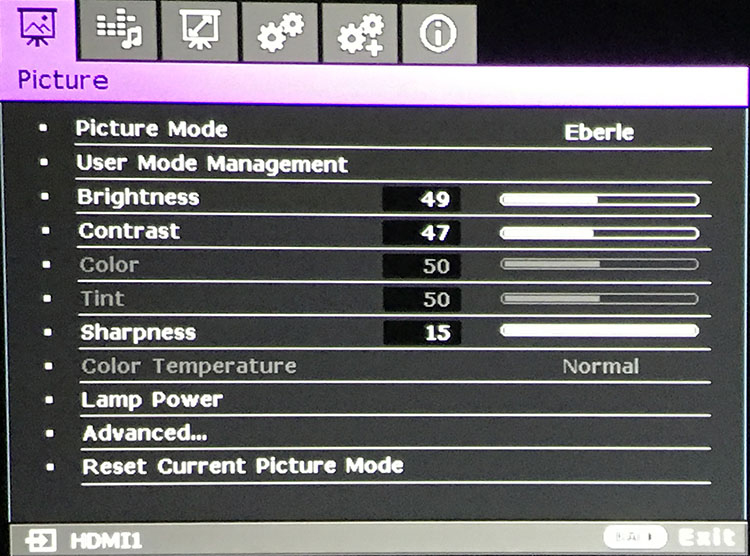
Once there, the Picture menu has everything you need for a full calibration. There are four preset modes plus two user memories. All are fully adjustable with options for lamp power, two-point grayscale, gamma presets, and color management. Two ISF modes can also be added with the appropriate unlock code. The user modes can be based on any of the presets; I chose Cinema to start my calibration.
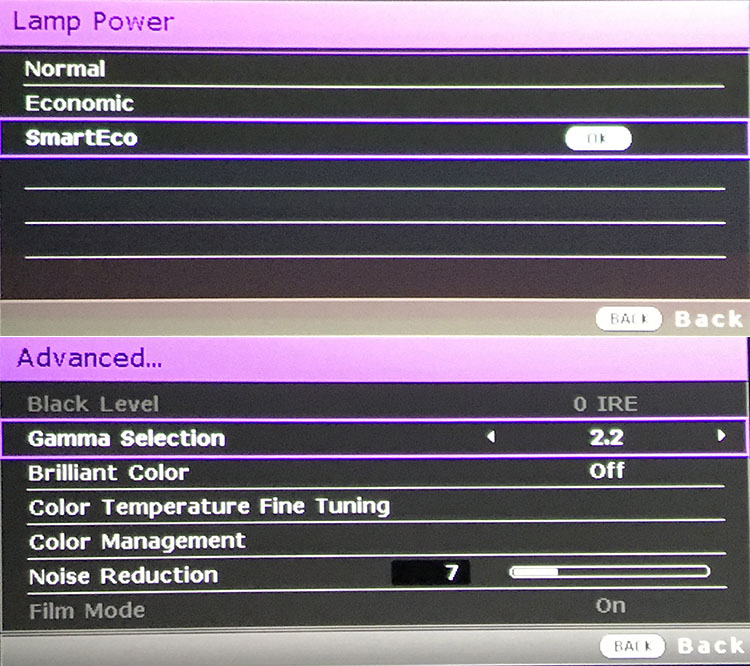
The lamp has two fixed levels and a SmartEco mode which modulates brightness according to content. It works much like an auto-iris and will visibly improve contrast. I noticed no pumping or other related artifacts during my viewing sessions.
The Advanced sub-menu has a black level threshold for component signals, gamma presets from 1.6-2.8, Brilliant Color which enhances mid-tone brightness, a two-point grayscale control, and a full CMS with hue, saturation, and luminance sliders for all six colors.
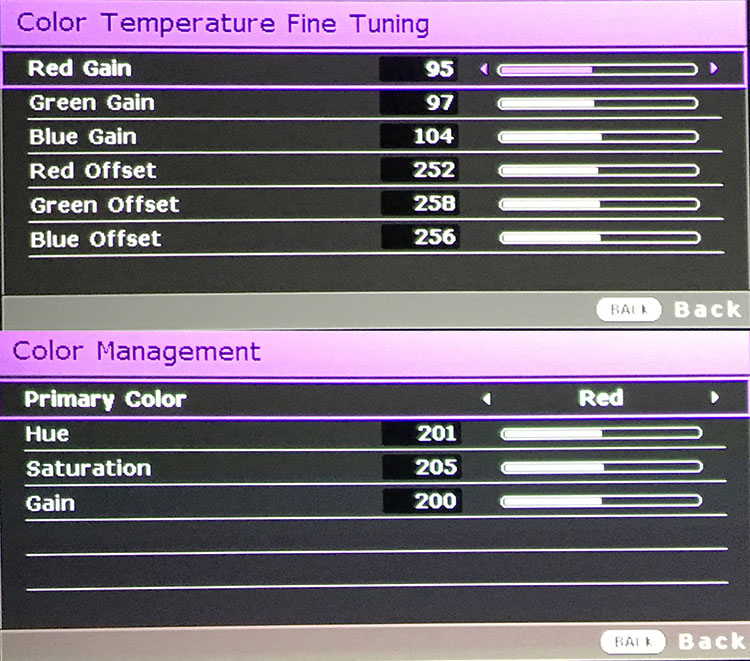
The RGB and CMS sliders offers fine resolution and begin at center-range which makes achieving balance very easy. The native color gamut in Cinema mode is nearly spot-on with Brilliant Color off so I didn’t have to do much with the CMS. Grayscale runs a bit warm by default so I made liberal use of the controls to achieve excellent tracking. Gamma measures right on spec at every preset so I chose 2.2 for all viewing. It delivers decent contrast, excellent detail, and good image depth.
Secrets Sponsor
Aside from a traditional calibration, there is little else needed to dial in the HT3050. The only other option one might wish to change is the HDMI Format. By default, it’s set to Auto which will clip below-black signals in RGB mode, but it will pass above-white. I prefer this method of calibration because it maximizes the display’s dynamic range. There’s little need to render BTB information when it so rarely appears in actual content. I’d rather not waste the contrast potential. To set the black level, I use a 0-10% step pattern rather than a PLUGE with BTB information.
I have spoken in previous reviews about the inherent advantages and disadvantages of DLP versus LCD/LCoS projectors. DLP offers unparalleled clarity with its single-chip design and short, reflected light path. It also has superior motion processing free of the smear and motion blur common to sample-and-hold technologies like LCD. But that method delivers superior contrast and can go toe-to-toe in the sharpness department with its imaging chips are properly aligned and quality optics are used.
The HT3050 looks as good as the best DLP projectors I’ve had in my theater, and that includes the high-end models. Its accurate Rec.709 gamut displays beautifully natural and saturated color and a level of detail found only in the most expensive LCD and LCoS displays. The image I’m seeing here is far better than a $899 price tag would suggest.
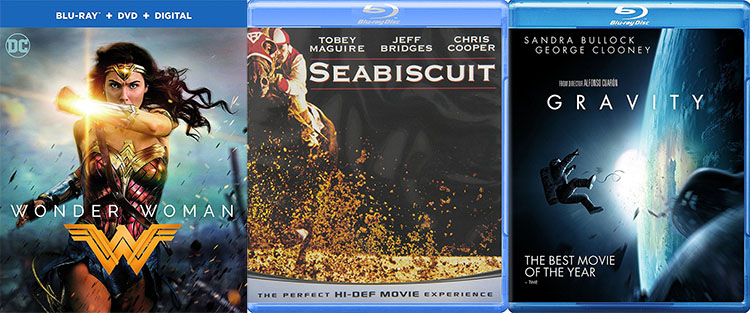
Wonder Woman has a vivid color palette with lots of natural hues, despite the heavy use of CGI. Flesh-tones looked perfect on the HT3050 with razor-sharp detail in textures and no evidence of moire in the fine shades seen in the sky or at the beach. Action scenes look particularly good as even the fastest motion retains full resolution. It may not be 4K but I haven’t seen fast movement this well-rendered on any Ultra HD display using LCD-based light engines. Using the SmartEco bulb setting makes the picture nice and bright but never harsh or fatiguing. Only the deepest blacks fall short here. Nighttime scenes are rich with detail and free of dithering but dark gray is about as low as it goes. It’s easy to overlook this weakness when a few highlights are present.
Secrets Sponsor
Seabiscuit is my favorite test for natural color. Its warm tones are difficult for any but the most accurate displays to render. With this rich saturation comes lots of detail and fantastic image depth. The HT3050 delivers on all counts. Despite giving away some dynamic range to the competition, I’ve rarely seen this film look better. The reds of jockey’s uniforms looked particularly nice as did the bright red lipstick worn by many women in the crowd scenes. Along with bright clear highlights, the detail in men’s dark coats can easily be seen.
I had to check out the HT3050’s starfield performance so I cued up my copy of Gravity. As expected, the background isn’t quite black but stars pop right out of the texture as do the highlights surrounding ships and other objects floating in space. Detail in things like spacesuits and control panels is almost touchable. The finest textures are clearly visible.
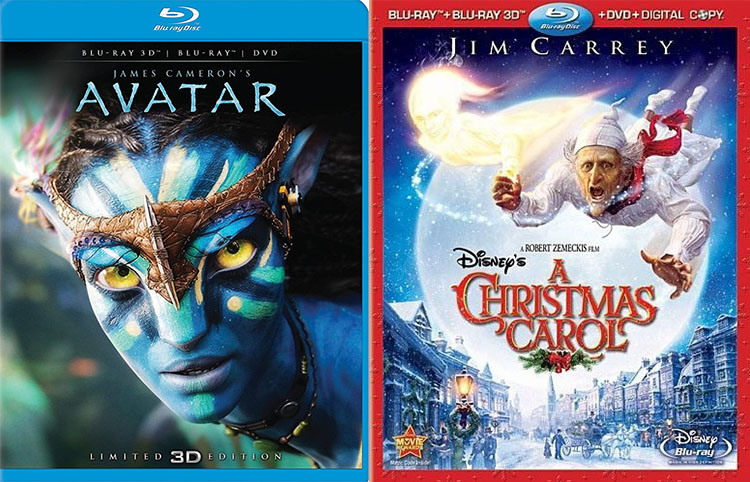
3D is almost dead in the flat panel market but many projectors still include the feature. BenQ makes sure it’s not considered an afterthought in the HT3050. I measured almost no crosstalk, and saw none in any of the clips I watched. Peak brightness is about average for the category but is high enough to enjoy films like Avatar and A Christmas Carol.
The latter is still the standard by which I judge all other 3D content. No film-maker has embraced the format as thoroughly as James Cameron. It offers every possible torture test for a 3D display. The color palette covers all the hues from warm to cold and everything in between. Dynamic range is tested too with dark forests punctuated by brightly-lit plants and glowing objects. Through it all, a projector must render a deep three-dimensional stage which the HT3050 easily does. High motion resolution and artifact-free 3D combine to create a reference-level picture. I wish there were a bit more output available but I still had no trouble enjoying the entire film.
Disney’s A Christmas Carol takes place mostly in dimly-lit interiors. It’s fully CGI with fairly realistic depictions of human and ghostly characters. The darkest material retains high levels of detail but is somewhat murky at times. Blacks remain a dark gray and are relatively dim. But when a candle-lit object appears, the sensation of depth increases. The 3D effect always remains intact.
In all viewing, I found SmartEco to be the best lamp setting along with my calibration in the Cinema mode. The brightness shifts were never visible and contrast was excellent in all but the darkest content. 2D films are bright and detailed while 3D is clean with a great sense of depth and only a bit lacking in overall luminance. Lens quality is far beyond what one would expect at this price point and motion resolution is always optimal thanks to that lightning-fast DLP chip.
I briefly tried watching a few clips using the built-in speakers. They are of decent quality for their size and will provide ample output without distortion in small spaces. Since they fire directly back at the viewer, the mind is sometimes challenged to couple audio and video elements, but BenQ’s solution is as good as any other similarly-equipped projector can boast.
To test the HT3050’s color accuracy, I used an X-Rite i1 Pro Spectrophotometer facing the projector’s lens and fitted with its diffuser attachment. Luminance readings were taken with a Spectracal C6 tri-stimulus colorimeter facing a 92” diagonal Stewart Filmscreen Luminesse with Studiotek 130 material, gain 1.3, at a 10-foot distance. Patterns were generated by an Accupel DVG-5000 and controlled with CalMAN, version 5.7.
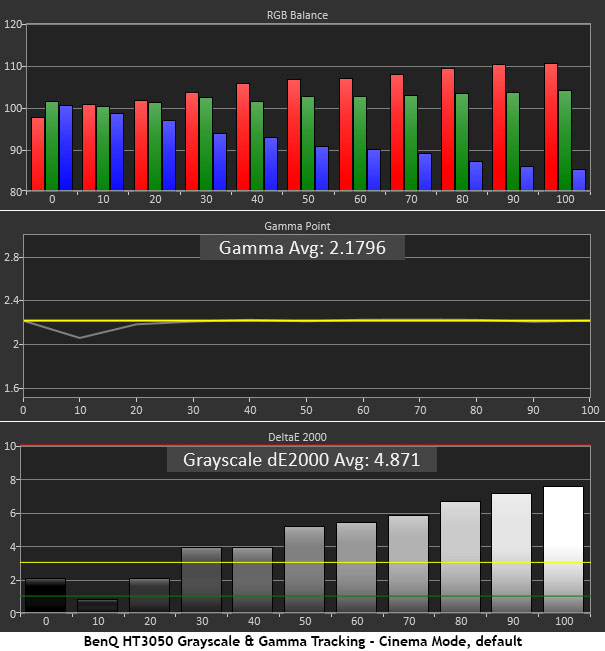
The HT3050’s Cinema mode is the best starting point for calibration. While the grayscale tracking runs a bit warm, it’s not too far off the mark with maximum errors under 8dE. Gamma is nearly perfect except for a tiny dip at the 10% brightness level. This can be fixed by simply lowering the brightness (black level) slider one click. I kept the bulb in its Economic mode during the adjustment phase, then switched to SmartEco once my work was complete.

The Color Temp Fine Tuning sub-menu offers gain and offset sliders for red, blue, and green. They are very precise and begin at center-range, making a balanced adjustment easy. It’s also nice they don’t interact. I brought everything in line in less than 10 minutes. In addition to tweaking brightness to fix the gamma dip at 10%, I also lowered the contrast slider from 50 to 47 to eliminate a blue-clipping issue at 100% brightness. That, coupled with my RGB adjustments delivered near-perfect gamma and grayscale tracking. It doesn’t get better than this. You’re looking at reference-level performance here.

With a pre-calibration average error of 3.46dE, there is little need for the color management system. In fact, most of the errors seen above can be fixed with grayscale adjustments. After dialing that in, I tweaked a few settings in the CMS just to further balance luminance levels and tweak the magenta hue. The only thing I couldn’t make better was 100% red. That primary is just a tiny bit outside its target though as you can see, the error is barely visible.
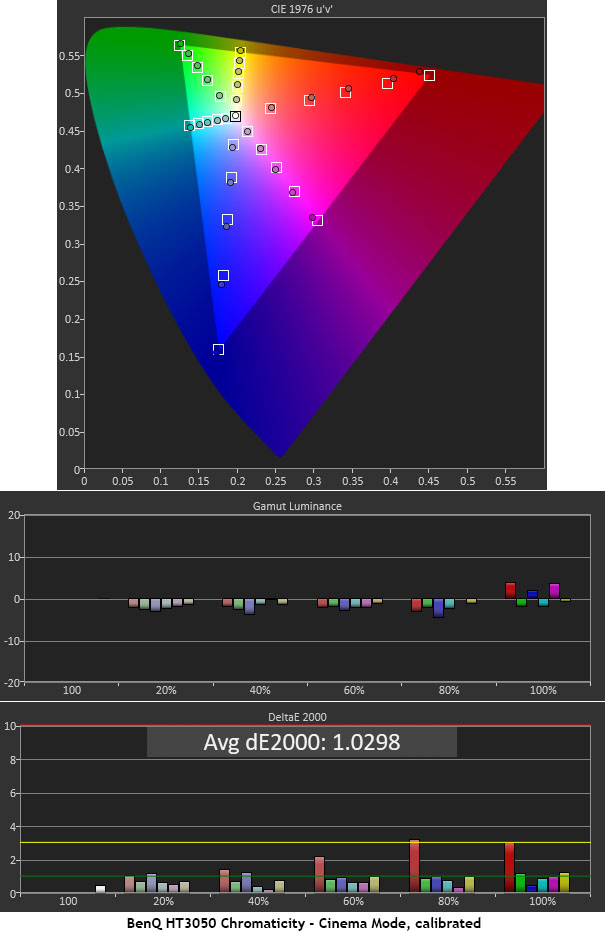
Calibration brings the average color error down to a super-low 1.0298dE. That is also reference-level performance; something you typically find in professional displays and computer monitors. To achieve accuracy this good in a $899 projector borders on astounding. BenQ has really done its homework here. Charts like this translate to perfectly-natural color in all content (mastered to Rec.709), and tremendous color detail with no clipping whatsoever. If it’s in the content, the HT3050 will display it exactly as intended.

Most modern displays, even value-priced models, offer decent video processing and the HT3050 is no exception. Aside from the 2:2 cadence and 4:2:2 chroma failures, there are no issues with interlaced or 24p material. The HDMI settings have options for video or PC levels. You’ll have to choose the latter if you want to see below-black in RGB mode. Interestingly, above-white signals appear regardless of the setting. I stuck with video mode to maximize dynamic range. The 4:2:2 chroma failure is not uncommon. But you’ll have to use a pretty old source component to see that format.
For a home theater display, the HT3050 is on the bright side, like most small projectors these days. After calibration, in the bulb’s Economic mode, I measured 30.7319fL peak, .024fL black, and a contrast ratio of 1282.1. This is native performance with no lamp modulation or iris control.
You can increase both contrast and output by selecting the SmartEco bulb mode. There, you’ll see 47.1522fL peak, .0237 black, and 1965.3:1 contrast. I recommend this mode for all viewing. The picture pops nicely and no image pumping was noticeable in my tests.
Max output can be found in the Bright mode with 82.0394fL peak, .043fL black, and 1909:1 contrast. This mode can be calibrated but correcting the green errors will reduce brightness by about 50%.
In 3D mode, the bulb power can still be changed if you wish. I stuck with SmartEco and achieved 6.0956fL peak, .0049fL black, and 1232.1:1 contrast. Crosstalk was a non-factor at just .04%.
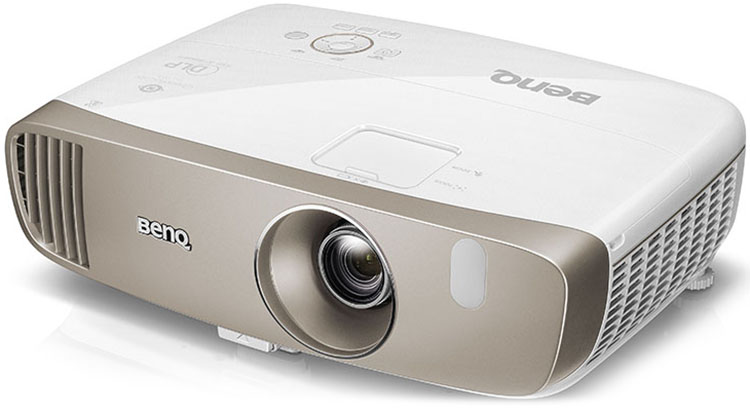
At $899, THE BENQ HT3050 sets a high standard among budget projectors. Its optics and accurate color are equal to or better than many costlier displays.
- Premium optics deliver a razor-sharp picture
- Accurate color
- Precise calibration controls
- Quiet fan
- Excellent remote
- Better black levels
- Greater lens shift
While no display is perfect, the BenQ HT3050 3D DLP Projector has few faults, and no issues of consequence. For $899, it delivers image quality and performance that competes easily with models costing a lot more. For most prospective buyers, it will come down to which technology is best suited for their particular viewing environment.
Enthusiasts building a dedicated theater space on a budget will certainly want to consider this DLP. It delivers a bright image through quality optics and can render the finest detail offered by modern video content. With its inherently-accurate color gamut and a few adjustments to its two-point white balance control, you’ll see a reference-level image that is as good or better than any projector at any price. The only thing I found a little wanting were black levels. That is the one area where DLP gives quarter to LCD and LCoS. But unless an entire film takes place in the dark, it’s impossible to ignore the extra clarity and motion resolution I saw from the HT3050.
If you’ve read my past projector reviews, you know I’m an LCoS fan, and I still keep an old Anthem LTX-500 installed as my reference display. As much as I love it, I can’t help but be seduced by the razor-sharp picture and brightly-saturated color of a projector like the BenQ HT3050. And if I were to watch movies in a more media-room-like setting, I’d be hard-pressed not to buy one. This compact DLP receives my highest recommendation.


